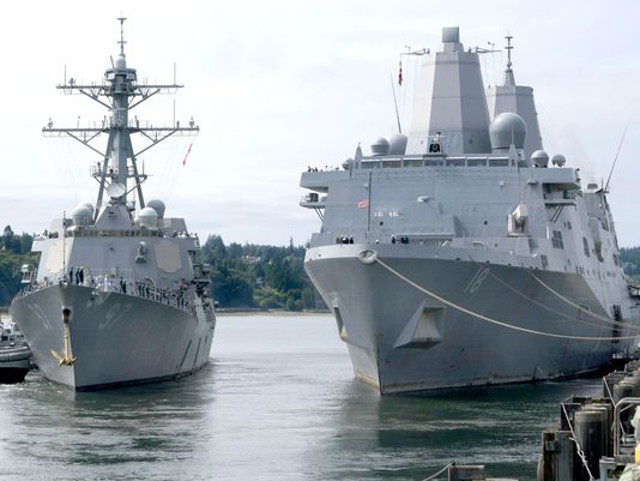Gulf shipbuilders gained a new amphibious ship late Friday (Dec 4), and the US Navy has agreed to add a destroyer at a key Maine shipyard. The moves reflect the resolution of a long-standing “hull swap agreement” involving the ships and the Navy’s two biggest shipbuilders.
Huntington Ingalls Industries received a $200 million not-to-exceed undefinitized contract action (or UCA) to order long-lead time material and perform design work on LPD 28, a yet-to-be-named 12th ship in the LPD 17 San Antonio class of amphibious transport dock ships. The ship, which the Navy did not request, was added by Congress to increase the fleet’s amphibious fleet and better meet US Marine Corps requirements.

The order of a new amphibious ship similar to the USS New Orleans, right, means another destroyer similar to the USS Halsey, at left, will also be built. (Image: U.S. Navy)
The total cost of a “fully-scoped” LPD 28 is expected to be around $2.023 billion, the Navy said last year. As a result of the award, General Dynamics will receive another DDG 51 Arleigh Burke-class destroyer beyond the batch already on order.
By creating a 12th LPD 17, the government invoked a hull swap agreement dating back to 2002, when a memorandum of understanding (MOU) between the Navy and its shipbuilders transferred the contracts of three LPDs that would have been built at the General Dynamics Bath Iron Works (BIW) yard in Bath, Maine, to what was then Northrop Grumman’s Ingalls and Avondale yards in Louisiana and Mississippi. Bath, in exchange, received three DDG 51s originally assigned to the Ingalls shipyard in Pascagoula, Mississippi.
Since then, the LPD program was cut from 12 to 10, then back up to 11 ships, ending with LPD 27. Northrop got out of the shipbuilding business and a new entity — HII — was formed, including Ingalls and the now-closed Avondale shipyards. The DDG 51 program was also scheduled to end at DDG 112, but was subsequently restarted by the Navy, awarding contracts to both Ingalls and BIW. As of now, all destroyer contracts through DDG 126 in fiscal 2017 have been awarded, split between Ingalls and Bath.
The MOU was reaffirmed by the Navy in 2009, when another swap agreement was signed between the Navy, BIW and Ingalls over work on DDG 1000 Zumwalt-class destroyers.
But the original MOU included a phrase that would come into effect should a twelfth LPD materialize: “A fourth DDG 51-class ship or equivalent workload would be awarded to [BIW] preceding, or concurrent with the award of LPD 28.”
With Congress’ action to add long-lead funding for LPD 28, the Navy and the shipbuilders worked to resolve the issue.
“Consistent with the ‘swap agreement,’ the Navy will award BIW a corresponding DDG 51 ship,” said Capt. Thurraya Kent, spokesperson for the Navy’s acquisition directorate. “This ship would be in addition to the currently contracted multiyear ships, subject to congressional authorization and appropriation.”
Based on the current 10-ship multiyear buy, which runs through DDG 126, the next ship could wear hull number DDG 127, although that determination is not yet official. Since LPD 28 was not requested by the Navy and added by Congress, the extra destroyer for Bath might also be outside the Navy’s existing multiyear destroyer buy.
More about this story on www.defensenews.com